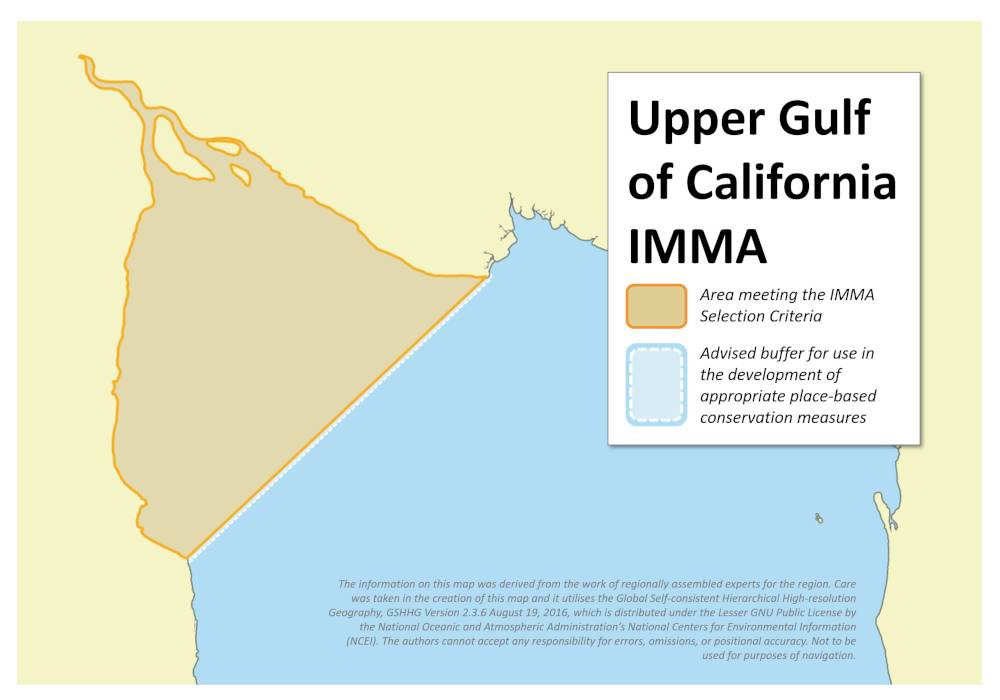Upper Gulf of California IMMA
Size in Square Kilometres
4 054 km2
Qualifying Species and Criteria
Vaquita – Phocoena sinus
Criterion A; B (1)
Marine Mammal Diversity
Delphinus delphis, Tursiops truncatus, Pseudorca crassidens, Orcinus orca, Balaenoptera edeni, Balaenoptera physalus, Balaenoptera musculus, Megaptera novaeangliae, Ziphius cavirostris, Zalophus californianus, Eschrichtius robustus, Kogia breviceps
Download fact sheet
Summary
The vaquita (Phocoena sinus) is endemic to the northern most part of the Gulf of California, Mexico, and its current range is confined entirely to the area encompassed by this IMMA. It is the most critically endangered mammal species in the world, with fewer than 10 individuals thought to remain in 2021. Vaquitas are being driven towards extinction through incidental capture in gillnets. Acoustic data have shown a substantial reduction in the area used by the remaining vaquitas. In 2019 CIRVA, the international vaquita recovery team, called on the Government of Mexico to fully mobilize its enforcement assets to eliminate illegal fishing in this small area where the last few vaquitas remain (12 km x 24 km), called the Zero Tolerance Area (ZTA). The Government of Mexico passed a regulation in 2020 prohibiting any fishing in the vaquita distribution area and declaring the ZTA a no-entry zone. Despite this and other regulations the Government has been unable to eliminate illegal fishing throughout the Upper Gulf and inside the ZTA.
Description of Qualifying Criteria
Criterion A – Species or Population Vulnerability
The Upper Gulf of California is, historically and currently, one of the most biologically productive marine regions on Earth. This productivity gives rise to an active fishery, and illegal gillnetting of shrimps, chano (Micropogonias megalops) totoaba (Totoaba macdonaldi) and other finfish, remain very high in this region (Brusca et al., 2017). For decades the recommendations by the Vaquita Recovery Team (CIRVA—Comité Internacional para la Recuperación de la Vaquita) has stressed that vaquita could be saved from extinction only if gillnets are banned throughout the species’ range and if fishers adopt viable vaquita-friendly fishing methods. The Vaquita is presently assessed as Critically Endangered (CR) on the IUCN Red List (Rojas Bracho et al., 2022). The estimated rate of decline is extremely high: a 48% decline was estimated in 2017 (95% Bayesian credible interval (CRI) 78% decline to 9% increase) followed by a 47% decline in 2018 (95% CRI 80% decline to 13% increase). The estimated total population decline since 2011 is 98.6% (Jaramillo-et al., 2019).
Criterion B: Distribution and Abundance
Sub-criterion B1: Small and Resident Populations
The entire species is confined within the limits of the IMMA. In the summer of 2018 it was estimated that fewer than 19 vaquitas remained (posterior mean 9, median 8, 95% CRI 6–19; Jaramillo-Legorreta et al., 2019). Acoustic data have shown a substantial reduction in the area used by the remaining vaquitas. Rojas-Bracho et al., (2022) used Expert Elicitation to examine data from two surveys (2019 and 2021) and suggested that the number of calves seen in the Zero Tolerance Area (ZTA) may have decreased between 2019 and 2021. The most likely number of vaquitas sighted in 2019 in the ZTA was about 11 individuals including 3 calves and the most likely number of vaquita seen in 2021 in the ZTA was about 7 or 8 individuals including 1 or 2 calves.
Supporting Information
Alvarez-Borrego, S. 2003. ‘Physical and Biological Linkages between the Upper and Lower Colorado Delta’. In: D. Rapport, W. Lasley, D. Rolston, N. Nielsen, C. Qualsety A. Damania (eds.). Managing for Healthy Ecosystems, pp.1081-1083. Lewis Publishers, Boca Raton, Fl.
Brusca, R.C., Álvarez-Borrego, S., Hastings P.A., Findley, L.T. 2017. ‘Colorado River flow and biological productivity in the Northern Gulf of California, Mexico’. Earth-Science Reviews, 164: 1-30.
Jaramillo-Legorreta, A.M., Cardenas-Hinojosa, G., Nieto-Garcia, E., Rojas-Bracho, L., Thomas L., Ver Hoef, .M., Moore, J., Taylor, B.L., Barlow, J. and Tregenza, N. 2019. ‘Decline towards extinction of Mexico’s vaquita porpoise (Phocoena sinus)’R. Soc. open sci.6190598190598 http://doi.org/10.1098/rsos.190598 (Accessed 8 June 2022)
Rojas-Bracho, L., Taylor, B.L. & Jaramillo-Legorreta, A. 2022. Phocoena sinus. The IUCN Red List of Threatened Species 2022: e.T17028A214541137. https://dx.doi.org/10.2305/IUCN.UK.2022-1.RLTS.T17028A214541137.en. Accessed on 14 October 2022.
Rojas-Bracho., L. and Taylor, B.L. 1999. ‘Risk Factors Affecting the Vaquita (Phocoena sinus )’. Marine Mammal Science, 15: 974-989
Rojas-Bracho, L., Taylor, B.L., Booth, C., Thomas, L., Jaramillo-Legorreta, A.M., Nieto-Garcia, E., Cardenas-Hinojosa, G., Barlow, J., Mesnick, S.L., Gerrodette, T., Olson, P.A., Henry, A., Rizo, H., Hidalgo-Pla, E. and Bonilla-Garzon, A. In press. More vaquita porpoises survive than expected. Endangered Species Research.


